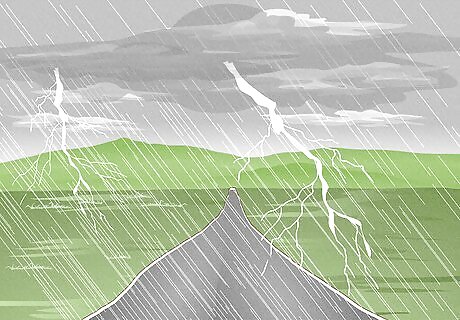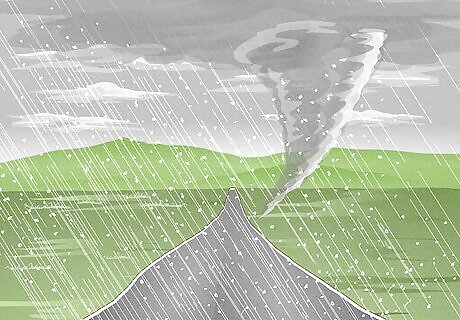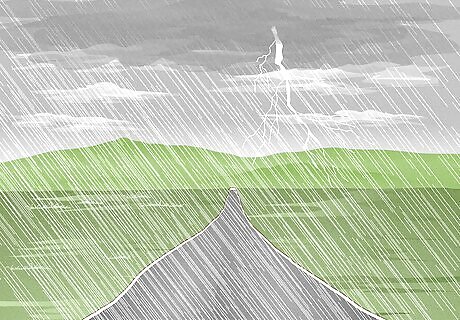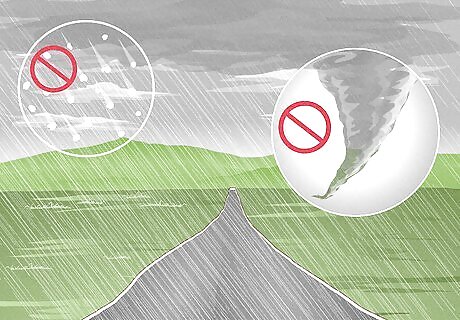
views
- Scattered thunderstorms cover a larger area, while isolated thunderstorms cover a smaller area.
- During scattered thunderstorms, rain often starts then stops, lightning is pretty frequent, and hail and tornadoes can occur.
- During isolated thunderstorms, rain is usually heavy but brief, lightning is typically infrequent, and hail and tornadoes aren’t very likely to occur, because they don’t originally last long so they can’t spawn any severe weather.
How are scattered and isolated thunderstorms different?

Scattered storms cover a large area, while isolated covers a small area. When your meteorologist tells you there are scattered thunderstorms on the horizon, they’re saying that almost 30-50% of your entire area will be affected by storms. An isolated thunderstorm is smaller. Because it’s just one storm, it covers less area, only affecting about 10-20% of the forecasted area. In general, this means that you’re more likely to get caught in scattered thunderstorms than an isolated thunderstorm. Neither scattered nor isolated thunderstorms tell you whether the storm’s severe or when it’s happening. These terms only refer to how much area the storm’s expected to cover. Some storms are classified as numerous or widespread thunderstorms. These cover an even wider area than scattered thunderstorms, affecting more than 60% of the forecasted area.
Scattered Thunderstorm Characteristics

Rain is usually more sporadic. With scattered thunderstorms, expect intermittent raining spread out over the span of a couple hours. Because these systems are made up of multiple storms, rain tends to stop and then start again as a new storm moves in. Usually, the rain lasts for 30 to 60 minutes, stops as the storm moves away, and then starts back up 30 minutes later. Scattered storms are often referred to as multi-cell storms because the storm system is made up of multiple different thunderstorms. Though the rain is usually sporadic, that doesn’t mean the storms will last all day. Always check your weather forecast to see when the storms are expected to start and stop.

Lightening is typically frequent. It isn’t uncommon to see lightning during scattered thunderstorms. This definitely means cancel your outdoor plans and stay inside! In fact, for more severe storms, lightning might strike the ground around 11 to 15 times during just a 5 minute period. To stay safe during a thunderstorm, take shelter indoors and keep away from windows. Don’t use any electrical appliances, especially ones plugged into an outlet, and stay away from water.

They can cause hail and tornadoes. Scattered thunderstorms cover a large area and can last for several hours, which means they can often spawn other weather conditions. Because they’re more likely to develop hail, tornadoes, and strong winds, scattered thunderstorms are more likely to cause damage than isolated storms. If you know that a thunderstorm is coming, make sure that you’re prepared. Remove debris like tree branches from your yard, put away outdoor furniture and other items that can blow away in the wind, and unplug electrical devices.
Isolated Thunderstorm Characteristics

Rain is typically brief, but heavy. During an isolated thunderstorm, you can expect a lot of rain. However, because these storms are small, that rain usually only lasts for about an hour before the storm moves on. Isolated storms are often called single-celled thunderstorms. This means that there is just one storm for the entire system. It can be hard to sleep through a strong thunderstorm, especially if they’re not something you enjoy. Wearing ear plugs or playing low, ambient music can help drown out the loud booms. If sudden bursts of lightning are keeping you up, leave a soft light on or wear an eye mask.

Lightning usually occurs infrequently. It’s uncommon to see a lot of lightning during an isolated thunderstorm. These small storms still produce it, so it’s still dangerous to be outside, but they don’t produce as much as scattered thunderstorms. During an isolated thunderstorm, you might see 1 to 5 lightning strikes during a 5 minute timespan.

They typically don’t spawn hail and tornadoes. Because isolated thunderstorms don’t generally last long, there isn’t as much time for them to develop more severe weather like hail, tornadoes, and strong wind gusts. These can still happen, but if they do, they’re often not very severe and cause less damage. An isolated storm can develop into a supercell storm if the wind speed and weather conditions are just right. This storm is very organized and powerful, generating damaging tornadoes, strong winds, and hail. Refrain from driving during a thunderstorm. If you’re already in the car when one develops, stay safe by driving slowly, giving the cars in front of you a lot of space, and pulling over if you can no longer see.
















Comments
0 comment